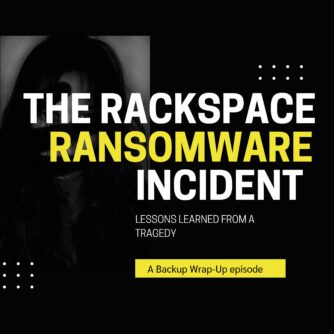You can't forget restores when talking about de-dupe, so let's talk about them.
This blog entry is in series. The previous entry is Two different types of de-duplication . The next entry is In-line or post-process de-duplication?.
Target de-dupe
If you're using target/hardware de-dupe (i.e. an IDT/VTL), then you're going to have an IDT/VTL at the remote site and you will do restores from it, assuming the site is up and running. You've got other options if you want to prepare (and you should) for if/when the site goes down.
- Copy your backups from the IDT/VTL to real tape and have your offsite vaulting vendor pick them up.
- Yuck. One of the reasons we did this was to get rid of tape at the remote site. There's no one there to manage it, and you'll have to pay extra to have your vaulting vendor actually pull tapes from your library and put them back when they come back from offsite.
- Replicate the IDT/VTL to another IDT/VTL that's driving distance away, but not next door.
- Most expensive option. This is your "offsite, but not way offsite" copy. In the event of a disaster, you can physically move this to the recovering site. With this option, you can also replicate this IDT/VTL to another one back at your central site, so you also have a "really offsite" copy in case of a major disaster that takes out both "local" copies.
- Replicate the IDT/VTL to another IDT/VTL that's shipping distance away.
- This makes sure you data is safe, but you're going to have a long RTO if you have a lot of data. If you've got a small amount of data, you could do a full restore across the wire,) If that's not viable due to the RTO, bandwidth, or size of the data, you're going to have to ship the IDT/VTL to the remote site or make tape copies in preparation for this and ship them to the remote site. You could also do a restore to disk at the central site and ship the restored disk to the remote site. All options are slow in comparison to option 2, but this is the cheaper option.
Source de-dupe
Your options are similar if you' re using source de-dupe.
- Full restore across the wire
- Assuming the site is still operational and you only have a dead server, you can do a full restore across the wire. This will take a while. Still OK for some, depending on amount of data, bandwidth, and RTO.
- Local restore using local appliance
- Assuming the site is still operational, you can meet more stringent RTOs by installing (in advance) a local appliance at the remote site and back up to it and have it replicate to the central site. It will then do all restores at the remote site as long as the site is still there.
- Replicate the local appliance to another appliance that's driving distance away
- Same store as the target option above.
- Replicate the local appliance to another appliance that's shipping distance away
- Same store as the target option above.
This blog entry is in series. The previous entry is Two different types of de-duplication . The next entry is In-line or post-process de-duplication?.
Written by W. Curtis Preston (@wcpreston), four-time O'Reilly author, and host of The Backup Wrap-up podcast. I am now the Technology Evangelist at Sullivan Strickler, which helps companies manage their legacy data






